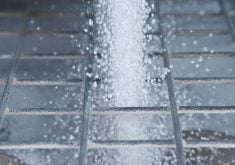Here is part two of The Western Producer’s four episode series on fertilizer return on investment: Video: Fertilizer won’t pay off without a plan
EDMONTON — Getting fertilizer right can be a challenge.
Multiple cropping histories, variable moisture and soil, spring temperatures and the timing of applications makes choices complicated, but not impossible.
“Doing nothing, that can be a problem,” says Rigas Karamanos of Koch Industries.
“Providing replacement of what you are taking out is the basic thing you can do. And you need to do it over the long term. But addressing more specific, site specific needs for each crop in each field, that will allow crops to grow to their potential.”
A big crop removes a lot of nutrients. Prairie farmers have seen some of their largest crops in history over the past five years.
“What does a 70 bushel wheat crop remove? I can tell you, it’s a lot,” Karamanos said. “The soil provides some, the farmer provides some. But if you get that big a crop, it had to come from somewhere and you need to make a plan that will put it back if you want it to happen again.”
For example, a large canola crop of 70 bu. per acre requires 200 pounds per acre of nitrogen, 120 lb. of phosphorus, 180 of potassium and 40 of sulfur.
Read Also

Phosphate prices to remain high
Phosphate prices are expected to remain elevated, according to Mosaic’s president.
“The plant residue will put some in. The soil will mineralize some, especially with some of these 20-year plus no-till fields we have now, if there is moisture. The rest is up to the farmer,” he said.
Nitrogen and sulfur are highly mobile, but the movement of other macronutrients is restricted by their chemical nature.
In some cases, nutrients are not even largely available in the year of application.
“Your phosphorus is mostly for next year, but if you don’t make a deposit into that account this spring, it will hurt you next year, and the year after that,” Karamanos said.
“Farmers need to apply nutrients that get tied up or need time to become available, with a longer term plan.”
Soil scientist Jeff Schoenau of the University of Saskatchewan said producers need to think about how their plants will find potassium and phosphorus in the soil.
As well, they need to consider what will happen to the plants when they do.
“Too little and you pay. Lower yields. Too much and you damage germination and emergence,” Schoenau told producers at the recent FarmTech conference in Edmonton.
He said producers know they have to keep rates down with vulnerable crops, but they often won’t push the phosphorus rates when growing wheat and other cereals.
Recent University of Saskatchewan research in chernozem soil near Central Butte, Sask., and grey to black, luvisol soil near Melfort, Sask., has shown that wheat exposed to 12-51 in the seed row stood up to 40 pounds of the nutrient.
Thirty lb. is typically acceptable in canaryseed, 25 for canola and mustard and 20 for flax. Brome grass, peas and alfalfa seed are at the most sensitive end of the scale at 10 to 15 lb.
“So you can tell which rotation you want to put the P into,” he said.
Wheat is also tolerant of extra nutrients, such as potassium. With many crops, however, research has repeatedly shown that equal amounts of phosphorus must be removed when it is added, or seedlings will suffer.
There is a higher potential for plant injury when it comes to sulfur in dry, sandy, high pH soil.
It is possible to seed place 10 to 20 lb. of ammonium sulfate per acre in a moist soil of neutral pH with a loamy texture. In those conditions, it was found that Invigor 5440 canola saw a three percent reduction in emergence after two weeks with a seed placement of just 10 lb. of 21-0-0-24 when compared to no fertilizer at all.
That fell to 92 percent at 20 lb. and 68 percent at 30 lb. Producers can expect to drop another 10 percent in plant count when adding 15 lb. of 12-51-0-0, MAP to the seed row.
Argentine canola is more tolerant than Polish types and sister crops such as camelina to damage from fertilizer applications.
“You need to feed the crop, but at what cost?” Schoenau said.
He found that napus canola could handle relatively high mixes of nitrogen phosphorus and sulfur in the seed row as an MES-15 fertilizer prill formulation. Plant emergence didn’t drop off until applications had exceeded 30 lb. of sulfur, 66 lb. of phosphorus and 26 lb. of nitrogen with the seed.
“But if you are having to choose between your P and S in the seed row, I would put the mobile sulfur off to the side in a separate band if you can and keep the P (with the seed),” he said.
Research at Central Butte found that elemental sulfur forms delivered a limited amount of sulfur to the crop in the year of application.
“We knew it was lower, but using PRS (soil probes from Western Ag), we looked at it over eight weeks and saw poor (release),” he said.
Producers who need the sulfur in the year of application must use more available forms of the nutrient, he added.
Karamanos said producers should look to soil tests to set a benchmark for a field so that they know what applications are needed to meet crop demands.
“Know your water supply. Know your nutrients. Build from there,” he said.
Schoenau’s research last year found high variability in soil tests, especially when it came to phosphorus levels. Monolith samples that captured soil in blocks, rather than in vertical cores found that “there is a lot of old residual P in the fields, in those old seed rows.”
“We saw much variability in 100 centimeters as we found in the whole field. So take samples over a 30 cm (per core) on P (and potassium) and 60 on N (and sulfur and average them). We had to core 40 to 80 cores (per field) to get a proper sample. We compared variable rate to constant rate of application (fields) and we found the variable rate smoothed out the nutrient variability across those fields.”
michael.raine@producer.com















